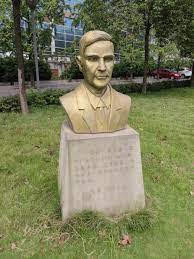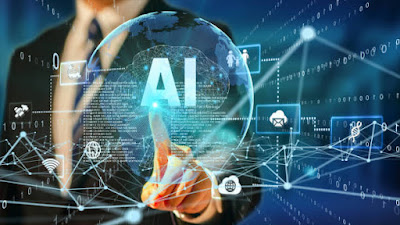The emergence of technologies that could fundamentally
change humans' role in society, challenge human epistemic agency and
ontological status, and trigger unprecedented and unforeseen developments in
all aspects of life, whether biological, social, cultural, or technological, is
referred to as the Technological Singularity.
The Singularity of Technology is most often connected with
artificial intelligence, particularly artificial general intelligence (AGI).
As a result, it's frequently depicted as an intelligence
explosion that's pushing advancements in fields like biotechnology,
nanotechnology, and information technologies, as well as inventing new
innovations.
The Technological Singularity is sometimes referred to as
the Singularity, however it should not be confused with a mathematical
singularity, since it has only a passing similarity.
This singularity, on the other hand, is a loosely defined
term that may be interpreted in a variety of ways, each highlighting distinct
elements of the technological advances.
The thoughts and writings of John von Neumann (1903–1957),
Irving John Good (1916–2009), and Vernor Vinge (1944–) are commonly connected
with the Technological Singularity notion, which dates back to the second half
of the twentieth century.
Several universities, as well as governmental and corporate
research institutes, have financed current Technological Singularity research
in order to better understand the future of technology and society.
Despite the fact that it is the topic of profound
philosophical and technical arguments, the Technological Singularity remains a
hypothesis, a guess, and a pretty open hypothetical idea.
While numerous scholars think that the Technological
Singularity is unavoidable, the date of its occurrence is continuously pushed
back.
Nonetheless, many studies agree that the issue is not
whether or whether the Technological Singularity will occur, but rather when
and how it will occur.
Ray Kurzweil proposed a more exact timeline for the
emergence of the Technological Singularity in the mid-twentieth century.
Others have sought to give a date to this event, but there
are no well-founded grounds in support of any such proposal.
Furthermore, without applicable measures or signs, mankind
would have no way of knowing when the Technological Singularity has occurred.
The history of artificial intelligence's unmet promises
exemplifies the dangers of attempting to predict the future of technology.
The themes of superintelligence, acceleration, and
discontinuity are often used to describe the Technological Singularity.
The term "superintelligence" refers to a
quantitative jump in artificial systems' cognitive abilities, putting them much
beyond the capabilities of typical human cognition (as measured by standard IQ
tests).
Superintelligence, on the other hand, may not be restricted
to AI and computer technology.
Through genetic engineering, biological computing systems,
or hybrid artificial–natural systems, it may manifest in human agents.
Superintelligence, according to some academics, has
boundless intellectual capabilities.
The curvature of the time curve for the advent of certain
key events is referred to as acceleration.
Stone tools, the pottery wheel, the steam engine,
electricity, atomic power, computers, and the internet are all examples of
technological advancement portrayed as a curve across time emphasizing the
discovery of major innovations.
Moore's law, which is more precisely an observation that has
been viewed as a law, represents the increase in computer capacity.
"Every two years, the number of transistors in a dense
integrated circuit doubles," it says.
People think that the emergence of key technical advances and
new technological and scientific paradigms will follow a super-exponential
curve in the event of the Technological Singularity.
One prediction regarding the Technological Singularity, for
example, is that superintelligent systems would be able to self-improve (and
self-replicate) in previously unimaginable ways at an unprecedented pace,
pushing the technological development curve far beyond what has ever been
witnessed.
The Technological Singularity discontinuity is referred to
as an event horizon, and it is similar to a physical idea linked with black
holes.
The analogy to this physical phenomena, on the other hand,
should be used with care rather than being used to credit the physical world's
regularity and predictability to technological singularity.
The limit of our knowledge about physical occurrences beyond
a specific point in time is defined by an event horizon (also known as a
prediction horizon).
It signifies that there is no way of knowing what will
happen beyond the event horizon.
The discontinuity or event horizon in the context of
technological singularity suggests that the technologies that precipitate
technological singularity would cause disruptive changes in all areas of human
life, developments about which experts cannot even conjecture.
The end of humanity and the end of human civilization are
often related with technological singularity.
According to some research, social order will collapse,
people will cease to be major actors, and epistemic agency and primacy would
be lost.
Humans, it seems, will not be required by superintelligent
systems.
These systems will be able to self-replicate, develop, and
build their own living places, and humans will be seen as either barriers or
unimportant, outdated things, similar to how humans now consider lesser
species.
One such situation is represented by Nick Bostrom's
Paperclip Maximizer.
AI is included as a possible danger to humanity's existence
in the Global Catastrophic Risks Survey, with a reasonably high likelihood of
human extinction, placing it on par with global pandemics, nuclear war, and
global nanotech catastrophes.
However, the AI-related apocalyptic scenario is not a
foregone conclusion of the Technological Singularity.
In other more utopian scenarios, technology singularity
would usher in a new period of endless bliss by opening up new opportunities
for humanity's infinite expansion.
Another element of technological singularity that requires
serious consideration is how the arrival of superintelligence may imply the
emergence of superethical capabilities in an all-knowing ethical agent.
Nobody knows, however, what superethical abilities might
entail.
The fundamental problem, however, is that superintelligent
entities' higher intellectual abilities do not ensure a high degree of ethical
probity, or even any level of ethical probity.
As a result, having a superintelligent machine with almost
infinite (but not quite) capacities but no ethics seems to be dangerous to say
the least.
A sizable number of scholars are skeptical about the
development of the Technological Singularity, notably of superintelligence.
They rule out the possibility of developing artificial
systems with superhuman cognitive abilities, either on philosophical or
scientific grounds.
Some contend that while artificial intelligence is often at
the heart of technological singularity claims, achieving human-level
intelligence in artificial systems is impossible, and hence superintelligence,
and thus the Technological Singularity, is a dream.
Such barriers, however, do not exclude the development of
superhuman brains via the genetic modification of regular people, paving the
door for transhumans, human-machine hybrids, and superhuman agents.
More scholars question the validity of the notion of the
Technological Singularity, pointing out that such forecasts about future civilizations
are based on speculation and guesswork.
Others argue that the promises of unrestrained technological
advancement and limitless intellectual capacities made by the Technological
Singularity legend are unfounded, since physical and informational processing
resources are plainly limited in the cosmos, particularly on Earth.
Any promises of self-replicating, self-improving artificial
agents capable of super-exponential technological advancement are false, since
such systems will lack the creativity, will, and incentive to drive their own
evolution.
Meanwhile, social opponents point out that
superintelligence's boundless technological advancement would not alleviate
issues like overpopulation, environmental degradation, poverty, and
unparalleled inequality.
Indeed, the widespread unemployment projected as a
consequence of AI-assisted mass automation of labor, barring significant
segments of the population from contributing to society, would result in
unparalleled social upheaval, delaying the development of new technologies.
As a result, rather than speeding up, political or societal
pressures will stifle technological advancement.
While technological singularity cannot be ruled out on
logical grounds, the technical hurdles that it faces, even if limited to those
that can presently be determined, are considerable.
Nobody expects the technological singularity to happen with
today's computers and other technology, but proponents of the concept consider
these obstacles as "technical challenges to be overcome" rather than
possible show-stoppers.
However, there is a large list of technological issues to be
overcome, and Murray Shanahan's The Technological Singularity (2015) gives a
fair overview of some of them.
There are also some significant nontechnical issues, such as
the problem of superintelligent system training, the ontology of artificial or
machine consciousness and self-aware artificial systems, the embodiment of
artificial minds or vicarious embodiment processes, and the rights granted to
superintelligent systems, as well as their role in society and any limitations
placed on their actions, if this is even possible.
These issues are currently confined to the realms of
technological and philosophical discussion.
~ Jai Krishna Ponnappan
Find Jai on Twitter | LinkedIn | Instagram
You may also want to read more about Artificial Intelligence here.
See also:
Bostrom, Nick; de Garis, Hugo; Diamandis, Peter; Digital Immortality; Goertzel, Ben; Kurzweil, Ray; Moravec, Hans; Post-Scarcity, AI and; Superintelligence.
References And Further Reading
Bostrom, Nick. 2014. Superintelligence: Path, Dangers, Strategies. Oxford, UK: Oxford University Press.
Chalmers, David. 2010. “The Singularity: A Philosophical Analysis.” Journal of Consciousness Studies 17: 7–65.
Eden, Amnon H. 2016. The Singularity Controversy. Sapience Project. Technical Report STR 2016-1. January 2016.
Eden, Amnon H., Eric Steinhart, David Pearce, and James H. Moor. 2012. “Singularity Hypotheses: An Overview.” In Singularity Hypotheses: A Scientific and Philosophical Assessment, edited by Amnon H. Eden, James H. Moor, Johnny H. Søraker, and Eric Steinhart, 1–12. Heidelberg, Germany: Springer.
Good, I. J. 1966. “Speculations Concerning the First Ultraintelligent Machine.” Advances in Computers 6: 31–88.
Kurzweil, Ray. 2005. The Singularity Is Near: When Humans Transcend Biology. New York: Viking.
Sandberg, Anders, and Nick Bostrom. 2008. Global Catastrophic Risks Survey. Technical Report #2008/1. Oxford University, Future of Humanity Institute.
Shanahan, Murray. 2015. The Technological Singularity. Cambridge, MA: The MIT Press.
Ulam, Stanislaw. 1958. “Tribute to John von Neumann.” Bulletin of the American Mathematical Society 64, no. 3, pt. 2 (May): 1–49.
Vinge, Vernor. 1993. “The Coming Technological Singularity: How to Survive in the Post-Human Era.” In Vision 21: Interdisciplinary Science and Engineering in the Era of Cyberspace, 11–22. Cleveland, OH: NASA Lewis Research Center.
















